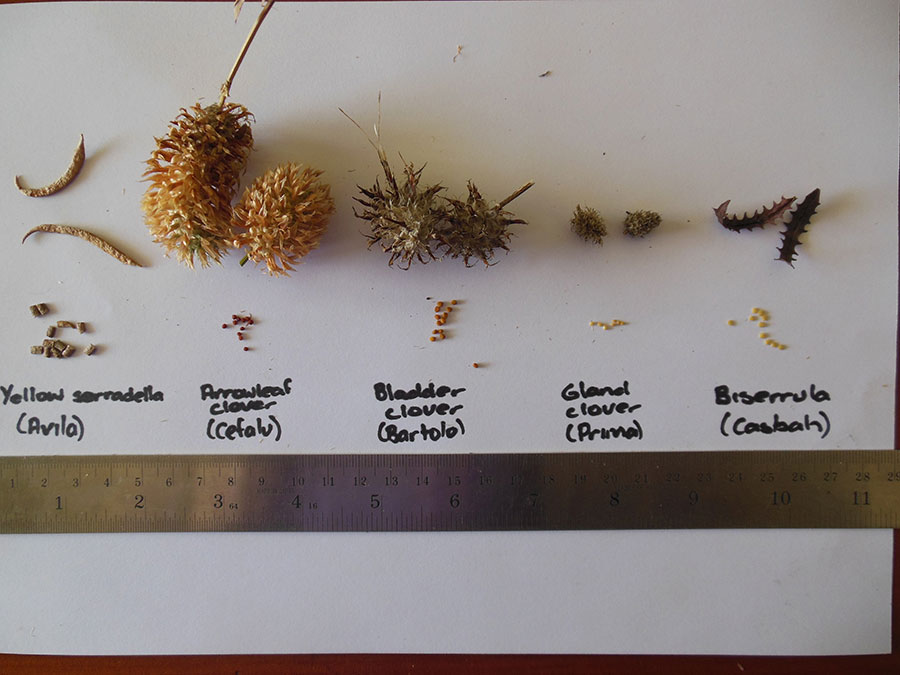Novel hard-seeded pasture legumes provide flexibility and reduce risk through alternative methods for pasture establishment, such as summer sowing, and create more flexible crop/pasture rotations. Additionally, seed costs can be reduced by harvesting these legumes on-farm with a conventional header, but each has their own individual characteristics to consider.
We recommend buying a small quantity of seed that can be grown in a nursery paddock and then using that seed to initiate a summer sowing program. The seed purchased for the nursery paddock, if coming from a reseller, will be scarified and a high percentage (usually more than 90 per cent) will germinate soon after sowing.
For that reason, sow your nursery paddock as you would a traditional legume such as subterranean clover or annual medic; that is, from mid-autumn onwards. Sowing rates for scarified legumes range from five to 10 kilograms per hectare depending on species, regional climatic conditions and machinery spacing.
When starting out with new hard-seeded legumes, many growers try three to five species in individual nursery blocks of five to 10 hectares each. This approach enables growers to evaluate the performance of various species on their farm without committing to a large financial outlay. They can then harvest the seed from species that performed best and use it to sow other areas of the farm.
The pods of hard-seeded pasture legumes are varied in shape, size and fibrous nature and this has implications for harvest (Figure 1 and Table 1).
Figure 1: Pods and seed of a range of hard-seeded legume pasture species.

Source:Belinda Hackney, NSW DPI
From our work with growers in NSW over the past decade and more recently with the Dryland Legume Pasture Systems project, the typical quantity of seed of annual legume species harvested with a header is shown in Table 1. The range in seed yields achieved reflects differences between regions (i.e. low verses medium-rainfall) and seasonal conditions.
Table 1: Typical seed yield and harvest considerations for a range of hard-seeded pasture legumes in NSW.
Species | Seed yield and comments on harvest |
|---|---|
Arrowleaf clover (Trifolium vesiculosum) | 300 to 800kg/ha. Many growers windrow arrowleaf clover for harvesting as the cultivars are relatively long-season and this prevents green stalks blocking the header. |
Biserrula (Biserrula pelecinus) | 100 to 350kg/ha. Best harvested under hot, dry conditions. Raking into windrows generally results in higher yields. Total seed available for harvest ranged from 500 to 1000kg/ha, but as the pod is papery a lot passed through the header, which will contribute to regeneration in subsequent years. |
Bladder clover (Trifolium spumosum) | 300 to 1200kg/ha. Bladder clover is a prolific seeder and is relatively easy to harvest. |
Gland clover (Trifolium glanduliferum) | 250 to 600kg/ha. Gland clover has a very high harvest index and harvests very well. |
French serradella (Ornithopus sativus) | 300 to 1000kg pod segments/ha. French serradella harvests well via direct heading. |
Yellow serradella (Ornithopus compressus) | 200 to 500kg pod segments/ha. Some of the old cultivars have hooked pods that can become entangled in the box, and growers recommend only filling the box to one-third to one-half to prevent problems augering out the pods. |
Source: Dr Belinda Hackney, NSW DPI
While these seed yields might appear low compared with yields achieved by winter crops, it needs to be remembered that the seeding rates for pasture sowing are much lower. For example, when using the unprocessed seed harvested on-farm for summer sowing, the rates required are 10 to 12 kg/ha for arrowleaf clover, biserrula, bladder clover or gland clover, and 20 to 30 kg/ha for serradella pods. Therefore, a small nursery paddock can yield enough seed to sow large areas.
It is important to note that some cultivars of hard-seeded legumes, such as the French serradellas Margurita and Fran2o , are protected by Plant Breeder’s Rights. This means that growers are able to harvest seed of these cultivars for their own use, but it is illegal to sell off-farm without a licence.
This research was part of the national Dryland Legume Pasture Systems project supported by the Australian Government Department of Agriculture, Water and Environment (DAWE) Rural R&D for Profit program and the Grains Research & Development Corporation, Meat & Livestock Australia and Australian Wool Innovation.
More information: Dr Belinda Hackney, belinda.hackney@dpi.nsw.gov.au; Ron Yates, ronald.yates@dpird.wa.gov.au

























































